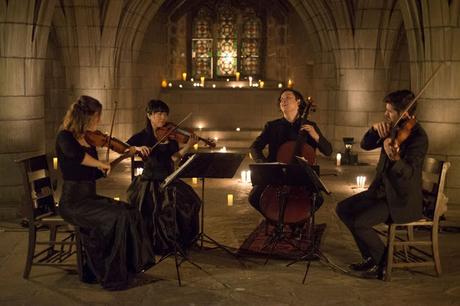by Paul J. Pelkonen

Silence: church in session: the Attacca Quartet in the crypt.
Photo by Tristan Cook © 2018 Unison Media.
These four young musicians have come a long way since forming at Juilliard fifteen years ago. And that maturity in their sound came from the very first notes of the first movement. The slow-rising drone of the opening sounded unnaturally loud in the hushed, stone crypt, showing why this is one of the best "found" venues for serious listening in recent years. The main thematic ideas unpacked quickly, with each of the four players taking a climb up the rising ladder of the first theme and then splashing back down in a series of arpeggios.
As cello (Andrew Yes) and viola (Nathan Schram) began to pulse out rhythmic figures, the two violins (Amy Schroeder and Keiko Tokunaga) engaged in lively comment, with the deeper strings occasionally rising out of the harmony to offer an opinion of their own. This friendly chatter was interrupted by slashing chords of modernity and violence, the first instance of this watershed work pointing the way forward to later composers.
This is Beethoven's second-to-last quartet, a five movement monster that makes tremendous technical demands on the musicians who would climb its starry heights. That is partially because Beethvoen instructs his players to take on the five movements attacca, leaping from one idea to the next with the shortest possible pause. At this point in his life, writing in silence, the composer started destroying the barriers and formal restrictions of the classical period, wrecking conventions and creating a template for what would follow in the 19th century.
On paper, the second movement looks conventional, a minuet in the classical style. And yet there are unique challenges, a muted passage that keens in an unearthly sound, followed by a skipping, game-like fugue that sounds like an imitation of the hurdy-gurdy. The movement necessitates strict rhythm control and closely argued exposition from the four players.. The playful dance resumed, led by Andrew See's cello but any pretense of gentility had been shattered by those unearthly, whining chords.
The Adagio is the summit of this work, a movement that moves with the rapidity of cooling lava. Beethoven wrote this movement after battling a long illness, and it is a slow and profound giving of thanks. In the crypt, the music had an unearthly quality, as the four players began this exploration of the void holding on by only golden threads of notes and chords. The keening figure returned in the violins, still sounding otherworldly as if the composer were still trying to reach that place "above the stars."
The last two movements bring the listener back to earth. The fourth is brief, a short, hopping dance that brings one back to reality following the mind-bending slow movement. The last is a set of complicated and increasingly knotty variations with unexpected outbursts of intense, impassioned feeling powered by the need to return to the dark original key. Along the way, one of these bursts veers into pounding rhythms and obsessive, violent chords: the seed of the next musical revolution that would come a century after this work premiered.

